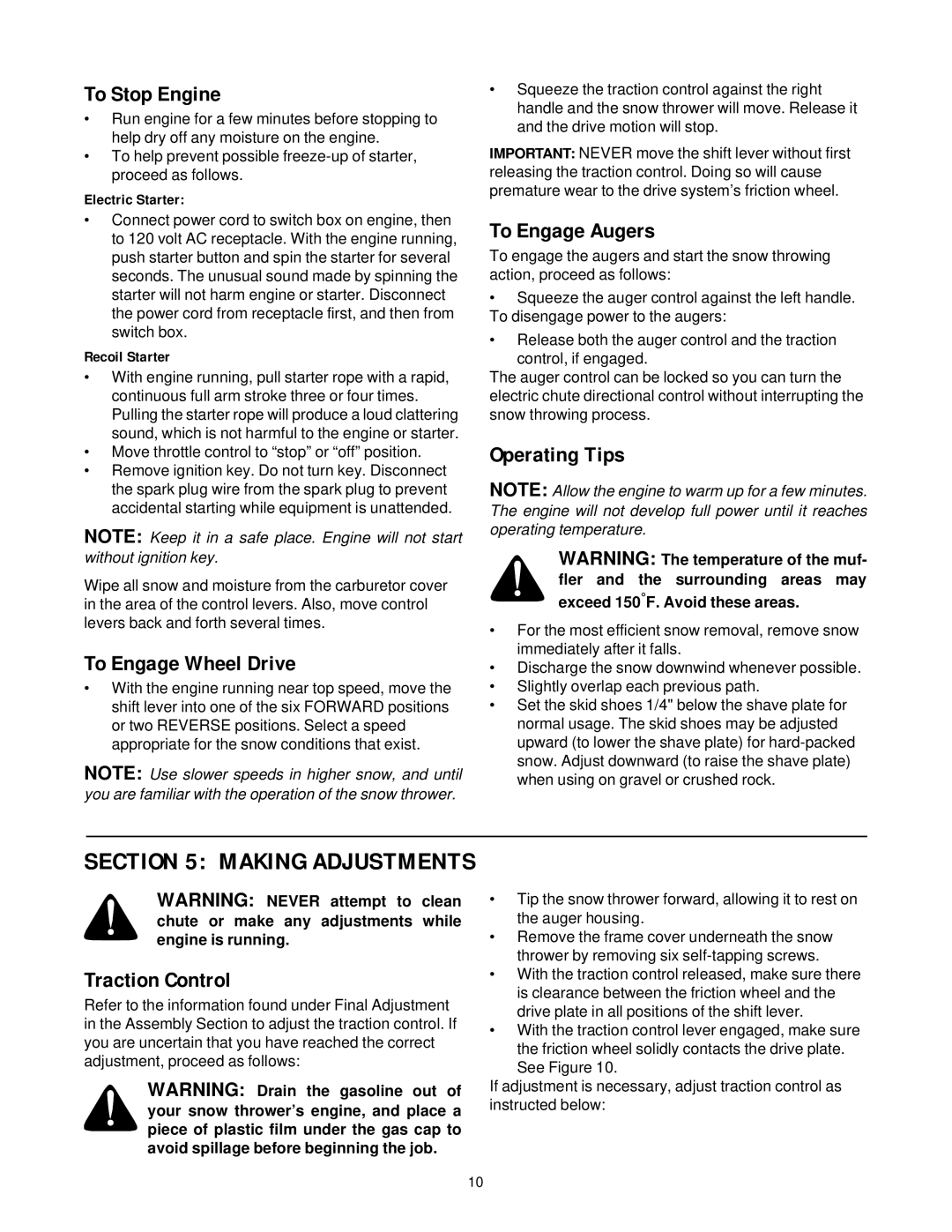
To Stop Engine
•Run engine for a few minutes before stopping to help dry off any moisture on the engine.
•To help prevent possible
Electric Starter:
•Connect power cord to switch box on engine, then to 120 volt AC receptacle. With the engine running, push starter button and spin the starter for several seconds. The unusual sound made by spinning the starter will not harm engine or starter. Disconnect the power cord from receptacle first, and then from switch box.
Recoil Starter
•With engine running, pull starter rope with a rapid, continuous full arm stroke three or four times. Pulling the starter rope will produce a loud clattering sound, which is not harmful to the engine or starter.
•Move throttle control to “stop” or “off” position.
•Remove ignition key. Do not turn key. Disconnect the spark plug wire from the spark plug to prevent accidental starting while equipment is unattended.
NOTE: Keep it in a safe place. Engine will not start without ignition key.
Wipe all snow and moisture from the carburetor cover in the area of the control levers. Also, move control levers back and forth several times.
To Engage Wheel Drive
•With the engine running near top speed, move the shift lever into one of the six FORWARD positions or two REVERSE positions. Select a speed appropriate for the snow conditions that exist.
NOTE: Use slower speeds in higher snow, and until you are familiar with the operation of the snow thrower.
•Squeeze the traction control against the right handle and the snow thrower will move. Release it and the drive motion will stop.
IMPORTANT: NEVER move the shift lever without first releasing the traction control. Doing so will cause premature wear to the drive system’s friction wheel.
To Engage Augers
To engage the augers and start the snow throwing action, proceed as follows:
•Squeeze the auger control against the left handle. To disengage power to the augers:
•Release both the auger control and the traction
control, if engaged.
The auger control can be locked so you can turn the electric chute directional control without interrupting the snow throwing process.
Operating Tips
NOTE: Allow the engine to warm up for a few minutes. The engine will not develop full power until it reaches operating temperature.
WARNING: The temperature of the muf- fler and the surrounding areas may exceed 150°F. Avoid these areas.
•For the most efficient snow removal, remove snow immediately after it falls.
•Discharge the snow downwind whenever possible.
•Slightly overlap each previous path.
•Set the skid shoes 1/4" below the shave plate for normal usage. The skid shoes may be adjusted upward (to lower the shave plate) for
SECTION 5: MAKING ADJUSTMENTS
WARNING: NEVER attempt to clean chute or make any adjustments while engine is running.
Traction Control
Refer to the information found under Final Adjustment in the Assembly Section to adjust the traction control. If you are uncertain that you have reached the correct adjustment, proceed as follows:
WARNING: Drain the gasoline out of your snow thrower’s engine, and place a piece of plastic film under the gas cap to avoid spillage before beginning the job.
•Tip the snow thrower forward, allowing it to rest on the auger housing.
•Remove the frame cover underneath the snow thrower by removing six
•With the traction control released, make sure there is clearance between the friction wheel and the drive plate in all positions of the shift lever.
•With the traction control lever engaged, make sure the friction wheel solidly contacts the drive plate. See Figure 10.
If adjustment is necessary, adjust traction control as instructed below:
10
